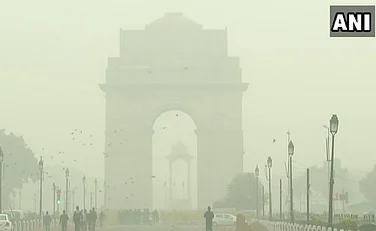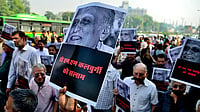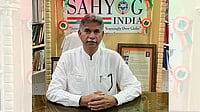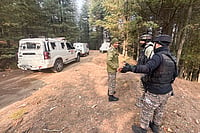Mohammad Irfan, 16, is the first literate person in his family. But Irfan and his younger brother, Mudassir Ahmed, 13, had to drop out of school in 2020 as the Covid-19 pandemic intensified their family's financial crisis. They were studying in Classes VIII and V respectively.
A few years ago, their parents had to abandon their traditional pastoral nomadic lifestyle after an unknown disease eliminated their livestock.
“We had no option but to share the responsibilities of our parents. Earlier, only my father used to work as a daily wage labourer. But the pandemic increased our economic problems,” Irfan tells Outlook, dismissing the possibility of getting enrolled in school again. While his younger brother, Ahmed, does menial jobs back home in Jammu and Kashmir's (J&K) Mansar village in Samba district, Irfan works as a cleaner with a truck that runs on national highway connecting Srinagar, Delhi, and different cities of Uttar Pradesh. Their three younger sisters haven’t discontinued studies, however.
Irfan says at the school they attended, they only learnt the Urdu alphabet and basic math, which wouldn’t have got them anywhere. Notably, as per Census 2011, only 17.8 per cent of the population from the twin-tribal communities can read and write to some extent.
Incidentally, Irfan and Ahmed were among two dozen students from the marginalised tribal Gujjar-Bakarwal communities in Samba district, who quit studies during the pandemic to ramp up their family incomes. Asked if he tried to avail any government welfare scheme, especially the recent benefits announced under the PM CARES for Children Scheme, Irfan replies, “Such schemes are out of reach for us.”
With schools shut for almost two years, the coronavirus pandemic forced tribal children to work longer hours. Many community members —who reside in tarpaulin tents on the peripheries of small towns and cities across J&K— have partially abandoned livestock rearing or have lost their animals to natural calamities, disease, or road accidents. Despairing lack of work —owing to disruption in the local economy after the pandemic and the abrogation of the semi-autonomous status of J&K, which was declared a union territory (UT) on August 5, 2019, these families lament that they are unable find work and pull in adequate wages. As a result, just like Irfan and Ahmed, many tribal children are now working to augment their family earnings.
This reporter has been a witness to the change. It was a mild autumnal September afternoon in Kashmir’s Anantnag district last year. Any path that led to the orchards of Dialgam village would ultimately wind its way to the camps of the Bakarwals, a pastoral nomadic tribal community of shepherds. The sight that attracted your attention was of Bakarwal children carrying baskets and sacks of freshly picked walnuts. They would appear out of nowhere and then vanish into the trees. Some paused to greet you with a broad smile and offer walnuts with their tiny hands that bore stains of dehulling and cleaning the raw, green fruit. Some of them were tending to sheep and goats. In-between the orchards were fields where children could be seen wielding sickles and de-weeding the crops growing there.

Talib Hussain, a noted activist from the Bakarwal community, explains the plight of the tribal children: “Even in the pre-pandemic world, the children did household chores and tended to the livestock. But after the pandemic, they are working outside their households to support their families.”
When a family or a community is plunged into financial distress, it has a direct bearing on their children’s education. Consider 17-year-old Mohammad Aslam’s story. A 10th standard student in Samba, near Jammu, he worked as a farmhand all through the summer in Anantnag district, over 200 kms away.
“Being the eldest son in the family, I had to earn. But due to my age, my employers wouldn’t pay me on a par with the adults,” he rues.
Meanwhile, his teachers sent him study material regularly, but his small cellphone screen did not provide him adequate readability. However, he is a very determined teenager and he wants to do something for his family, education or no education.
He says, “Whatever I can do, I am doing to pull my family out of poverty. Due to financial problems, some friends from my tribe quit school and took to work. I am also thinking along similar lines.”
According to Shahbaz Chaudhary, who has an M.Phil. from Jammu University on the Bakarwals, the plight of the community has to be seen to be believed.
“Economically, socially and politically, Bakarwals happen to be the most marginalised of nomadic tribes. In the absence of alternatives, they helplessly continue with their traditional pastoral life,” he says, adding that a major chunk of community members —called Aajhris— rear the livestock of well-to-do tribal families, and in lieu of their services receive food, money or shelter for their families.
“One can’t even imagine that a Bakarwal migratory family can own a smartphone and their children attend classes online,” notes Chaudhary.
Leave the Bakarwals aside, about 70 per cent of school-going children in J&K don’t have access to digital devices to attend online education. This was admitted as much in a written reply in Parliament by Union Minister of Education Dharmendra Pradhan in August this year. Even for those who own a smartphone, the J&K region is notorious for its poor connectivity with frequent forced internet shutdowns.
It was in the late 1970s that the then J&K government had launched a mobile school scheme to educate children from migratory populations. The schools travel with tribal communities like the Bakarwals, who move with their sheep from the plains of Jammu to higher reaches of Kashmir and return to the plains in the summer. The Peoples’ Democratic Party-Congress coalition government (2002-08) also set up seasonal schools —which provide education up to Class VIII— in the hilly districts. These schools start the academic session in May, and from October onwards, the students attend regular government schools in their respective home bases in the lower reaches and the plains.

Records show that over 40,000 students are enrolled at present in seasonal schools that have 1,100 teachers called Educational Volunteers (EVs). But, according to Raja Muzaffar Bhat, a Srinagar-based social and RTI activist, “some seasonal schools exist only on paper”.
In May last year, Qammar Raveen, a young Bakarwal woman with a postgraduate degree in political science as well as a B.Ed, objected to the setting up of bogus schools in Poonch district and the appointment of favoured candidates without adequate qualification as teachers. She alleges that her complaint has not been addressed so far.
According to activist Bhat, mobile schools don't function as envisaged. He says, “The majority of the mobile schools deprive students of their mid-day meal. Children attend classes under the open sky and their studies get disrupted during rain and windstorms. These schools don’t even have basics like blackboards and stationery.”
Secretary of the Tribal Affairs department, Shahid Choudhary, admits there are problems. He says, “We have also received complaints about mobile schools. The matter has been taken up with the authorities in the school education department.”
He maintains that his department is seized of the problems faced in educating the children of migrating communities and is addressing them.
Notes Chaudhary: “For the first time, our department has conducted a survey of the migratory population. The purpose is to create facilities along the migration routes and dhoks (highland pastures). We have also discussed the need for putting in place a mechanism for the appointment of teachers in consultation with ‘dhok committees’ comprising representatives from the local tribal population.”
For the migratory population, Choudhary further said the UT administration has decided to set up Eklavya Model Residential Schools (EMRS) on the pattern of Navodaya Vidyalaya (schools for nurturing excellence among students in rural areas).
“At least 11 such schools will be opened in seven districts,” he says, adding that priority will also be given to strengthening of supportive infrastructure for schools in catchment areas of the proposed EMRS. “We are planning 80 new student hostels and modernisation of the existing 26.”
So far so good. But far from the bustle of the secretariat in Srinagar, one remembers the children of an obscure Dialgam orchard explaining ways to remove walnut stains from their hands. How many more dark nights will it take for the proposed boarding schools to see the light of day? And when will the stains of child labour be erased from the Bakarwal community?


























